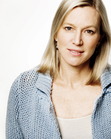Lee Woodruff's Blog
September 16, 2019
August Bookmarks
Then there’s Labor Day, aptly named as the gateway to what’s to come…back to school, weekends at home, the buckling down into work and routines. Summer dresses and white shorts get packed away.
Once crickets begin their late afternoon chirp in the August grass, I feel a wisp of the blues, mingled with nostalgia and excitement. Nostalgia for all the back to school stretches I experienced as a child, college student and then as a mother. Excitement… because fall is a new gear, faster, cooler, time to get down to business. Fall has a renewed purpose, whether we like it or not.
And while in the midst of your “getting back to it,” save some time for books, whether on audible, Kindle or turning the pages of a book at the end of a long, good day. Enjoy this crop of new August reads…
Fiction:
The Dearly Beloved by Cara Wall
Occasionally, a book dumps me into a rabbit hole until I find myself mourning the last page. And while my criteria might be different than yours, it usually starts with exceptional writing, the depth of the characters and, of course, the story. For those who share my love of Wallace Stegner, this book reminded me of “Crossing to Safety” in numerous ways. It’s a simple story that examines complex issues; love, marriage, faith, loss, perseverance and much more. Two couples, coming of age in the 50s and 60s and wrestling with the vicissitudes of the era; civil rights, the war in Vietnam, women’s rights. Both husbands co-share minister duties at a church in New York city, although they have different relationships to their faith. The two couples have a twinned, but complicated friendship that delves into four psyches of individuals encountering every day questions about friendship, truth, disappointment and belief. I highly recommend this read.
Devotion by Madeline Stevens
Like so many young girls before her, Ella has arrived in New York City from Oregon full of big dreams and with empty pockets. When she takes a nanny job for the young son of an Upper East Side couple, she’s transported into a world of privilege in an elegant brownstone. Lonnie, the pretty wife, is a talented writer who has been born into family money. Ella is immediately attracted to everything about her, rocketing between envy and coveting her life, which begins to grow to an infatuation. As Ella is pulled deeper into Lonnie’s world and her girlish affections, warning lights go off everywhere. Beware the bright flame, it’s easy to get burned.
The Ventriloquists by E.R. Ramzipoor
Recently, there have been a spate of WW2 novels that deal with lesser known subjects and this book is no exception. Inspired by the little-known “Faux Soir Movement” and its resistance heroes, this book is a combination of a heist tale and historical fiction, a kind of “Ocean’s Eleven” meets “All the Light We Cannot See.” Set in Brussels, 1943, a rag tag band of resistance fighters use their voice and risk their lives to publish a satiric newspaper mocking the Reich and combatting Nazi propaganda to rally the Allies. When they are captured, they must choose between using the power of their voice to paint the Allies as monsters or be killed. The real life story that inspired the book reminds us of the importance in illuminating the extraordinary acts of courage by ordinary people whom history forgot.
Non-Fiction:
Kochland: The Secret History of Koch Industries and Corporate Power in America by Christopher Leonard
Seven years in the making, the author, an investigative journalist, traces the rise of modern corporate America through the story of a powerful, yet secretive family corporation that most Americans know little about. With an annual revenue that exceeds Goldman Sachs, Facebook and U.S. Steel combined, Koch Industries is everywhere, from the fertilizers that make our food to the synthetics we wear to the diapers, chemicals and carpets we walk on. A genius businessman with a belief in free-market ruthlessness, Charles Koch began quietly amassing companies from Wichita, Kansas, with a view toward very long-term profits. Operating in deep secrecy, he and his brother David consolidated power over 50 years, transforming capitalism in a way that led to anemic unions, widened the income divide, stalled climate change progress and exerted vast control in the influence industry and politics. At times the book reads like a thriller, with epic characters waging battles worthy of Game of Thrones.
Non-Fiction Memoir:
Girl on the Block: A True Story of Coming of Age Behind the Counter by Jessica Wragg
In the vein of the tell-all foodie-memoir trend, (ala Anthony Bourdain or Sweetbitter) Britain’s top female butcher tells the story of how a simple local market job at 16 in Chesterfield, England led to being a rising star. She pulls the curtain back on the all-male meat industry and gives us a ringside seat to what it was like to be the only woman in the ultra-competitive, tradition-bound industry.
Finding herself behind the counter with too-large boots and an apron splattered with blood and animal innards, Wragg finds herself falling in love with “the craft of butchery.”
As her career moves forward, she masters animal anatomy and knife skills and begins to realize how she can bring her concepts for ethical meat eating to the industry, as well as help the other “women of meat” in the process. A talented writer, the book is also peppered with stories of Wragg’s life outside of work as well as recipes, facts about meat and explanations for the layman about how and when to carve.
Biography:
Barnum – An American Life by Robert Wilson
More than 125 years after his death, the story of “the world’s greatest showman” still inspires. The co-creator of Barnum and Bailey Circus was a brilliant impresario, a shrewd charlatan and a champion of wonder, joy and trickery. He has captured the world’s imagination since he first made international sensations of Tom Thumb, Jumbo the Elephant and so many more. Barnum once made a fortune selling tickets to see a mermaid, fashioned out of a monkey head and a fish body. He learned how to wow crowds and repeatedly reinvented himself, becoming one of Americas first millionaires. He suffered tragedy, bankruptcy, survived fires and willed himself to rebuild again. Much more than a cartoon ringmaster, he was also a state legislator, mayor, philanthropist, temperance advocate and the embodiment of the American Dream. The biography is an interesting and detailed look back at a period in history not unlike today, when scam and con artists blur the lines with celebrity, politics and showmanship.
December 13, 2013
A WARRIOR MOM
“When you become a parent, you might as well just open a vein.” I’ve long forgotten who said that to me, but as a mother, I immediately understood. Parenthood abruptly catapults one into the realization of how many ways you can fail at protecting your child from life’s randomness. Before you, at all times, one hundred little heartbreaks lie in wait.
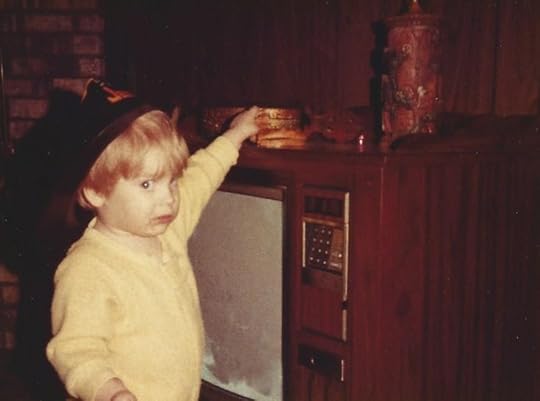
This is why military families have my deepest respect. When a son or daughter enlists, they pledge themselves to defend and serve this country. And when that child is deployed to an area of conflict, a parent serves too, uttering a daily prayer, while braced for the possibility that a phone call could rip through their life like a bullet.
When the phone rang on May 11, 2005, Diana Mankin Phelps’s first thoughts were “No, Lord why? I’ve got to get to my child!”
A half a world away in Iraq, her son Cpl. Aaron P. Mankin, was serving as a combat correspondent in the United States Marine Corps. He was filming from the top of a 26-ton Amphibious Assault Vehicle, carrying 17 other marines, when it rolled over an IED buried in the dirt road. As the bomb exploded, they were thrown ten feet in the air, crashing down in a ball of fire. All of the men were injured and six did not survive. Aaron was flown from the field hospital to Germany and 48 hours later, arrived at Brooke Army Medical Center in San Antonio in severe respiratory distress, with burns over 25% of his body. The entire trajectory of Diana’s life and her family’s was forever changed with one phone call.
As Diana’s third child, her baby, Aaron had a special place in his mother’s heart. You can see it in the way they act around one another; the deference and respect with which Aaron treats her, the outright pride and devotion that plays over her face as she watches him speak from the audience, or accompanies him to warrior events, where he is often the honored guest.
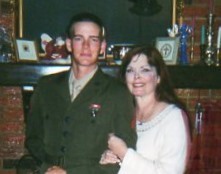
Aaron can still recall his first day of school, when he began to cry at the thought of leaving home and his Mom. “She took my hand and kissed it,” he said. “Her lipstick left a stamp and she told me this way she would be with me all day.”
Almost 20 years later, Diana would make the same promise to herself and to Aaron, only this time she truly would not leave his side. At the military hospital, her new role was to witness, comfort, care and advocate for her son during the more than 60 surgeries that would follow in the ensuing years. Battling back the fear and heartbreak that could so easily consume in the wee hours of the night, she remained by Aaron’s side for the next nine months.
One thing Diana shares with so many other military parents whom I have met along the way is moxie, a determination and an ability to soldier on, to call upon resilience and rely upon blind faith when the going gets tough.
Born in Fresno, California, Diana moved to Oklahoma, where she graduated high school and then took a job in Arkansas working in the home office of Wal-mart and Sam’s Clubs, climbing the corporate ladder in a number of different professional capacities.
During those years, she began to develop health issues and was ultimately diagnosed with lupus and degenerative disc disease, precipitating a retirement in 1993. While staying by Aaron’s side during his difficult and often painful recovery, she quietly battled her own health issues and pushed down the frequent pain that accompanied her illness.

Diana’s story is that of the caregiver. She is the mother in the equation, the other side of war. Parents like her don’t wear a uniform. They don’t get a parade or a medal for their actions. Diana is one of the hundreds of thousands of loved ones on the front lines here at home, a witness to the back end of war, both the obvious, visible wounds and the hidden traumatic injuries, that can be triggered by the littlest things.Diana is one of the legions of people pushing the wheelchair or dispensing the medications, lifting up a loved ones spirits with a cheerleader-like devotion, explaining away their son’s jitters in a crowded public place or requesting restaurant seating so their warrior can feel safe with his back to the wall.
And because life doesn’t take a vacation when a loved one is injured, Diana soldiered on with her own basket of troubles. During the years she was helping Aaron to recover, she lost her own brother and sister, both of her parents and battled cancer. Yes, I said cancer. On top of her other medical issues, Diana was diagnosed with breast cancer in 2009, undergoing a mastectomy and chemotherapy in 2010.
How, one wonders, did she find the fortitude to get up some mornings, to try to understand that maybe there was a grander plan? Writing her book, “A Mother’s Side of War,” was part of her own catharsis and it fulfilled a need to try to educate about war from a parent’s perspective.
This past November 11th, as I stood at our town’s Veterans Day ceremony this year, I noticed the shocking absence of young people in the audience. Heck, there wasn’t even much of an audience to begin with.

Where were the children, I wondered? Where were the very people who would be called upon to care for those who have served and been injured, especially in the wars in Iraq and Afghanistan? Where were the 99% who benefit from the freedoms that the less than 1% uphold and fight for?
As the divide grows between the civilian and military worlds, the lack of a draft means that only a small fraction of our population will understand the definition of serving. We risk losing something as a culture that fosters that “good shiver” up the spine when the flag is unfurled, a patriotic song plays, or jets do a flyover.And can we please set aside here all of the things we’d like to fix about America? Just for a moment? It’s too easy to pick apart what’s wrong. The trick is to put our collective shoulders into fixing it.
There was something potent at work in the wake of September 11th, a palpable unification that rose up and fused us together as a land. Where is that now, I wonder? Much of that pride is still very alive and well amidst our military families. It’s a sense of mission and purpose and a belief that, despite our warts, America is still a country that stands for and tries to deliver great things, even as we sometimes stumble and fail.
Books like Diana Mankin’s memoir help us to keep the stories of our country alive. It is the story of sacrifice, of bravery and of love of country. Her story is all of our stories. It’s the story of America.
“A Mother’s Side of War” by Diana Mankin Phelps is available at amotherssideofwar.com or at your preferred online retailer.
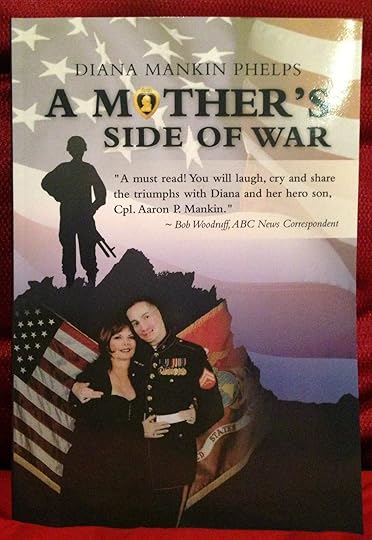
During this season of giving let us remember those like Diana and Aaron who have given so much
For information on how you can give, visit the Bob Woodruff Foundation.
www.leewoodruff.com facebook.com/leemwoodruff twitter@LeeMWoodruff
October 20, 2013
Glassybaby
Lung cancer. That will stop a conversation. More than any of the frightening medical diagnoses, that one seems extra ominous. Someone utters the words “lung cancer” and I think of devastating, almost insurmountable odds.
At the age of 32, that’s what Lee Rhodes was told when she learned that her worrisome symptoms were actually a rare form of lung cancer. She was a young mother deep in the thick of raising three small children. This was not supposed to happen, not how life spooled out.
She went on to endure uncertainly, surgery and rounds of chemo, and there were clearly moments when she questioned whether or not she would live to watch her babies grow. Stress and fear and sadness, those are all immeasurable barriers to the healing process and Lee Rhodes had many important reasons to live.
One day, searching for a simple way to still the “what ifs” that reverberated around her brain in a mental sound track, she spontaneously dropped a tea light in a glass cup that her husband had created in a glass blowing class. Sometimes the birth of life’s great ideas begins as simply and as spontaneously as that.

That one isolated act was a fulcrum moment for Rhodes. As she watched the color of the glass glow and reflect the warmth of the flame, she felt her world slow for a moment. She was infused with a sudden sense of deep down calm. The simple candle in the colored glass settled her soul in a way that none of the other centering therapies had been able to do up to that point in her journey.
“In my mind, that candle in the glass contributed to my healing. It made me step back, relax and take a deep breath,” Rhodes remembers.
From that day forward, Lee Rhodes filled her home with a series of the colorful glass vessels and they continued to inspire her. At first, Lee remembers that people lit them for her, as a way to instill hope. In time, as she began to recover, she began to light them not just for herself, but also for others.
And when Rhodes went on not only to survive, but to kick cancer’s butt, the disease had given her a mission to try to help other people fighting in what she calls “the battlefields of chemotherapy rooms.” Gradually, she began to share her talisman for calm, giving the colorful votive holders away to people who were suffering. As she watched the popularity of the holders grow along with demand, she began selling them out of her garage.
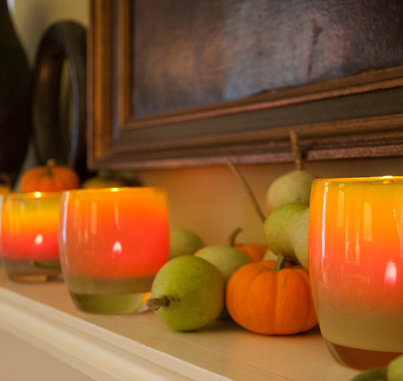
In 2001 Rhodes started Glassybaby, with the goal of raising money to help cancer patients ease the journey of treatment by covering unreimbursed healthcare costs. These unmet needs range from something as simple as transportation to chemo or babysitting money while a patient goes to the doctor, to the more weighty costs of medical treatment itself.
Today, Glassybaby produces beautiful, colorful hand blown glass vessels in more than 400 colors. The craftsman are all located in the United States and part of the beauty of their creations is the subtle variation in shape, size and hue, a testament to the artisanal quality of the finished product. Each vessel is comprised of three layers of glass and requires four glass blowers to produce, hence their ethereal glowing qualities.
Glassybabys come in names as varied as the products themselves like Wet Dog, Frog Hunting, Wingman and Crème Brule. “They are,” says Rhodes, “individual pieces of art at each table.”
The business currently has stores in Seattle, her home base, and is opening in San Francisco and New York, with more cities to come. Jeff Bezos, founder of Amazon, was so enthralled with the Glassybaby product and mission that he persuaded Rhodes to sell him 20% of the company.
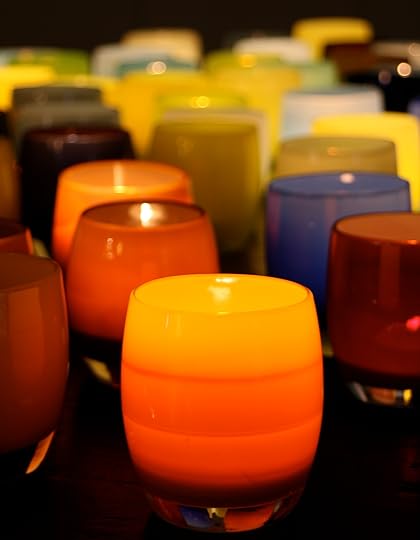
There are 70 plus glass blowers producing roughly 500 votives a day, which has translated into the company being able to donate more than $1.4 million to date to charities that help cancer patients with costs not covered by health insurance. The company’s ultimate goal is to give away $1 million a year.
Like Rhodes, many of the people who work at Glassybaby have been touched by cancer in some way. And it’s that passion and commitment to the cause that remains one of the reasons the company has continued to grow at a steady rate.
“Everyone in a waiting room is fighting the same enemy. But it’s very profound when you meet people who literally don’t have the money for the bus fare to get them to chemo,” she says. And it’s that part of the journey she is determined to ease through the sale of her beautiful glass vessels.
I first learned about Glassybaby when a friend gave me a gorgeous purple candleholder as a gift. For months it sat in my office, glowing. And then another friend found a lump in her breast.
In the spirit of Lee Rhodes, I brought my Glassybaby to her home one day and lit a votive. Art is meant to be shared, not sequestered. And my friend (who is thankfully now cancer free) told me that she would light it during low moments. The glow reminded her that she was connected to a tribe of determined people who were fighters, each tending their own embers of hope. And she was a fighter too.
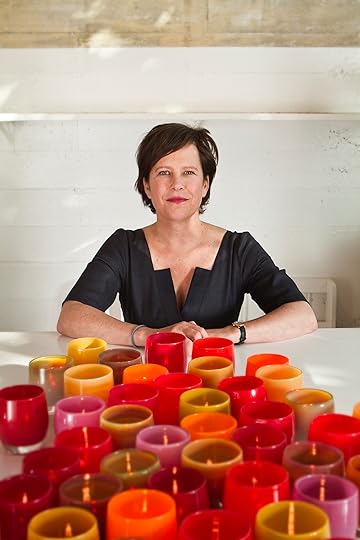
This month, I choose Lee Rhodes as my person of inspiration. She took her own experience and her story and created something that could light the way for others yet to come. So it seems especially relevant, during breast cancer awareness month, to shine a light back on Lee and her beautiful, multi-colored mini beacons of hope.
You can learn more or purchase your own Glassybaby creation at www.glassybaby.com.
www.leewoodruff.com facebook.com/leemwoodruff twitter@LeeMWoodruff
September 23, 2013
A Remarkable Persson
Things come in bunches. And so this spring was a season of loss when first a friend passed away, then my mother-in-law, and finally another extraordinary woman, whom I actually only met three times in person, but who impacted the world in important and aspirational ways.
The remarkable Helen Persson was 95 years old when she died. And although I recognize that none of us are going to ever cheat death, especially in their ninth decade, the news stayed with me for days.
People throw around the description that someone has a “sparkle in their eye,” but in her case it was a physical fact. Her hazel eyes virtually twinkled and snapped with life, interest and a little bit of healthy mischief.
She used her influence wisely, and understood the power of giving back when the world has handed you good fortune. And to that end, she gave generously during her lifetime in the areas of education, the arts and assisting our military families.
Helen is one of those American dream stories that continue to reinforce that a little luck, combined with elbow grease and chutzpah, can carry someone a long way down the road. She grew up in Bethlehem, Pennsylvania, the daughter of Russian immigrants who imbued her with a strong faith and a love of music. And she would go on to sing professionally, encouraged by an officer in the Navy who had heard her perform. Music and opera singing became both her passion and vocation. And after leaving the military, Helen would have many roles in operatic productions, often playing the lead.
She got her nursing degree at the University of Pennsylvania College of Nursing and shipped out after Pearl Harbor during WW2 with the Navy Nurse Corp. Working her way up, she attained the rank of Lieutenant Commander. When I met Helen for the first time, she emotionally recounted some of her experiences caring for the wounded in the war. She spoke of the boys she could not save, the ones who asked for their mothers before they died. She understood first hand that head injuries were among the most devastating and severe wounds of war.
It was this connection, her close association with caring for those who had sustained blast injuries that brought me into Helen’s orbit for the first time. She had followed my husband Bob’s career as an anchor on television. When the news was announced that he had been hit by a roadside bomb, Helen instantly understood that the prognosis was not good.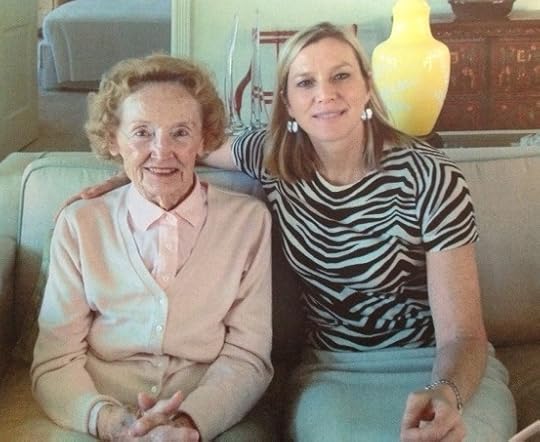
On my first visit to her home in Pam Beach, Helen told me that she would never forget the young men she had cared for. The experience of tending to young soldiers, who were wounded in battle, would forever forge her appreciation for and dedication to our nation’s military families. Helen considered herself connected to them.
I would hear the sentiments and sorrow articulated by Helen echoed by many of the nurses who served in Vietnam. Their pain and trauma was, like so many of our medical personnel in wartime, never given an outlet or acknowledged by the military and the public. No one, in pervious wars, recognized the post traumatic stress that comes with treating injured and dying soldiers. Most of the incredible medics, nurses, doctors and other health professionals who served our troops lived silently with their internal scars of trauma and stress.
It was our mutual connection to Colgate University that brought me into contact with Helen. Her husband, Ted Persson ’42, was a generous benefactor to Bob’s and my alma mater and a mutual friend from the University introduced us. Although I was eager to speak with her, at that first meeting I was unsure of what condition she might be in at her age.
The woman who greeted me, with that signature twinkle and wonderful laugh, was not compromised one bit by any cognitive clouding. She was sharp as a tack, asking brilliant questions and telling stories of her gutsy, accomplished life.
She had read our book, “In an Instant,” and she wanted to know more about the Bob Woodruff Foundation, which helps injured service members and their families cope with the wounds of war. She asked thoughtful questions about our mission and drilled me on how our dollars were spent.
It was a few weeks later, after that first visit, that our fledgling foundation got a phone call from Helen. She wanted to make a donation, to help give us the wings we needed to tackle some of the long-term issues plaguing our service members.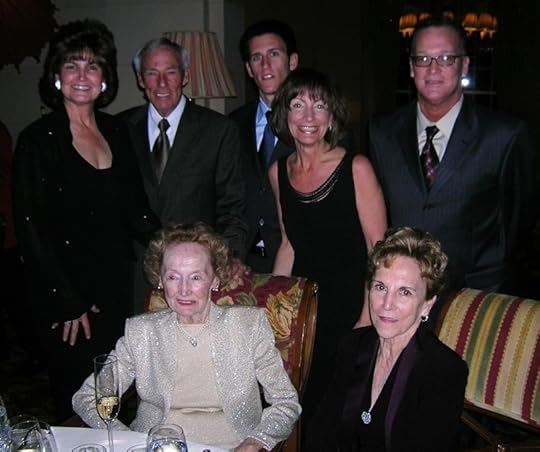
I can picture exactly where I was standing when I got the call from the foundation’s Executive Director. I was at a spa where two dear friends had kidnapped me to “caregive the caregiver” as they called it, following the grueling year of putting our family back together during Bob’s long recovery. I stepped outside into the sunlight to take the call.
“Are you sitting down,” our executive director asked. I wasn’t.
“I just got off the phone with Helen Persson. She’s writing us a check for one million dollars.” Silence. I was speechless. And then I burst into tears and sat down.
For each of those remaining years of her life, Bob and I were honored to be invited to her annual birthday party in Palm Beach. They were always intimate affairs, with the people surrounding her she loved most, her family, her fellow opera buffs, some of the folks from the hospital where she was a benefactress and many others who were the definition of devoted friends.
At the first party I attended, Helen belted out a song for her guests, accompanied by a pianist. I remember being captivated by the look of pure joy on her face at the ability to entertain us all.
Over the years we stayed in touch through phone calls and notes. We put a scrapbook together for her of some of the families that her generous donation had helped. I was able to travel to one more of her birthday celebrations, but each time Bob was called away for a journalistic assignment. Once he was actually holding plane tickets and then got called away the night before.
Both of us had Helen’s 95th birthday written in pen on our calendars. But this past year she pulled a fast one on us, holding the party on the weekend presumably so that it would be easier for out of town guests to travel there. We were both very disappointed to realize that we had solidly booked commitments on the date of her soiree. We would miss another year. But Bob taped a video message to her and told her he would be there next year, regardless of whatever news was breaking and where.
Helen’s death shouldn’t have shocked us. At some point the body simply gives out. But the news filled me with remorse. We would not get another chance to see Helen, to hear her stories about the past, to listen to the laugh that always made you smile when you heard it. 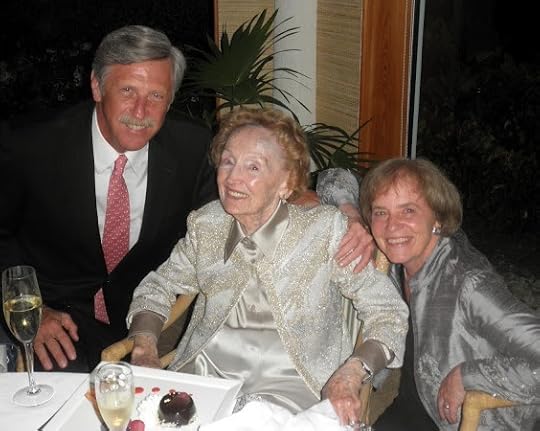
Weeks later, once again, a call from our foundation. Helen Persson had remembered the military families and the wounded in her will. She had honored the work of the Bob Woodruff Foundation with another substantial donation. More tears of joy. This time I made sure to sit down.
This year we will be establishing an award for Helen Persson as a way to honor her legacy of service. It is fitting that the intention of the award is to recognize a “Persson” who has given admirably in the area of veteran’s causes and veteran’s service organizations.
I like to imagine that somewhere up there in the big old heavens, Helen is reuniting with many of her old friends, her husband and family, and I imagine a number of the young men whom she once cared for during World War II. That’s the way I like to picture it, anyway.
Helen Persson left her mark in ways too numerous to detail here, and if I did it would sound like a lengthy obituary. She lived fully and loved large, and she remains a shining example to me that there are big and little ways to positively impact this world. She didn’t just twinkle, she shone. May we all move through the world a little like Helen.
www.leewoodruff.com facebook.com/leemwoodruff twitter@LeeMWoodruff
September 11, 2013
LHJ-Let's Talk About Sex (And Why I'd Rather Just Go To Sleep)
Excerpt from Ladies Home Journal, LHJ.com/Community/Your Stories
 Okay, I'll say it: After four kids and 25 years of marriage, it's not easy to get in the mood for sex. My husband would disagree.
Okay, I'll say it: After four kids and 25 years of marriage, it's not easy to get in the mood for sex. My husband would disagree.
I can give you the play-by-play of my first date with the man I married: the Greenwich Village restaurant, our heads tilted in conversation as if drawn by magnets. I can recall exactly what I wore, how I asked him to zip up my dress when he arrived early, and the electric charge I felt as his hand grazed my back. I remember the long walk home, the urgent kisses on the couch -- all that ardor and passion.
Fast-forward almost 25 years. We brush our teeth side by side and climb under the sheets. The body pillow that I embrace to ease my back lies between us. (Bob calls it my boyfriend.) We murmur good night and within a minute I can hear his gentle snores. He knows that because I'm exhausted and a morning person, there is not a prayer he's getting any nooky tonight.
What happened to the sultry young woman who melted with just one meaningful glance from her husband? Where did she go? How did we morph from the couple who couldn't keep our hands off each other to a couple who need a monthly planner to even think about conjugal relations? To be honest, I can take or leave sex, and mostly I'd rather leave it. Oops, did I just say that? Read More..
www.leewoodruff.com facebook.com/leemwoodruff twitter@LeeMWoodruff
August 6, 2013
Summer Bribes
But I did feel certain of one thing: our kids would be avid readers.
When I think back to my childhood, and the one my husband describes, we both loved to disappear into a world of books. Reading took us to new places, requiring only imagination to color in the lines or draw the landscape.
I fell just a little bit more in love with Bob when he first described his boyhood self to me as a kid “buried in a book.” That’s when I knew, among other things, that he was the man for me. Naturally, we would create a little cache of eager beaver readers. Forget nature—that part was all about nurture, right?
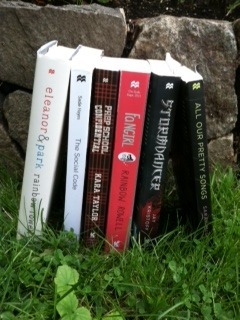
I couldn’t have been more wrong.
Oh, hang on a tick, no one in my household is illiterate, no one is using rope for a belt or wears cardboard shoes. All four of my kids have a decent grasp on current events. But much to my great sorrow, they don’t read for pleasure. So if you are one of the lucky people whose progeny devour books like Halloween fun-size candy bars, you can stop reading now. We need not feel the sting of your smugness.
I got through July and I put my foot down. Summer was half over! The tide had to turn. I announced to my 13 year olds that they would read or lose their allowance. Read beyond their summer reading assignments and, well, there would be a new article of clothing in it for them.
Admitting this two-pronged “punitive plus bribery” approach to making my kids read, feels a little like standing up in an AA meeting and announcing that I’m an alcoholic.
But I figure, if I out myself, maybe some of the rest of you won’t be so hard on yourselves. You’ll abandon the unproductive search for where you failed, after years of modeling solid recreational reading habits, countless bedtime stories and dedicated visits to your public library. It’s a jungle out there in the world of modern childhood— the concept of reading for fun today feels more like being the Victorian bathing costume in the Miss America Bikini Contest--- its just not as sexy as its technologically entertaining competitors.
Bribing kids to read? Horrors, say the ghosts of child librarians past. I wasn’t beneath using Skittles as a reward for potty training. Is this really any different? Isn’t regular reading as essential as proper pooping if you’re going to thrive in this world?
As an author I have the pleasure of knowing and working with some wonderful people in the book business. So I canvassed a few industry folks and came up with a stack of current YA books. I’m no dummy. I’m not going to try to force-feed Jane Austen right now. I chose the Harry Potter-style lane. Every crack addict knows you need to begin with a gateway drug.
“All Our Pretty Songs” by Sarah McCarry was first up, a new YA summer entry that got great reviews. My girls looked over the cover, their summer freckles furrowing as they read the flap; Cool Hand Lukes, those two, careful not to display too much overt enthusiasm. An eyebrow raised in interest. The lure and hook snagged in the fish’s mouth. Success, I thought to myself, displaying my poker face.

I gathered titles like “Social Code,” “Fan Girl” and “Prep School Confidential.” These books also had wonderful cover art to sweeten the offering, a short skirt here, a mysterious kissy face there. Hah! Take that you addictive TV series, you seductively shot “Gossip Girl” and fake blood strewn “Vampire Diaries” episodes! Yes, yes, shame on me. I do permit them to watch these shows, but I’m what you call an “almost-everything-in-moderation” kind of mother. Current pop culture has its own important place in adolescence.
The books arrived. And so they read.
Here we are now, in the early days of August. Just before lights out, the three of us tuck in, we open our books, stretch out our legs on the bed, the moths beat against the screens in the hushed dark outside. There’s a bullfrog or two, singing baritone with all this recent rain. OK, OK, so I over-dramatized the scene a little, it does feel sorta triumphant. And it’s blissfully quiet inside, no vampire victims are screaming on TV, no Park Avenue prepsters are tossing their highlighted manes and huffing away on their Tory Burches.
There is only the flickering of the theater of our minds. Only the sound of we three drawing breath. We are reading. Pure happiness.
Perhaps we will work our way to iconic titles like “The Wind in the Willows,” (although that window has probably passed) “Little Women,” “The Hobbit” or any of the endless classics that could enrich their sponge-like minds. Or not. Is it important that my girls have read Thackeray or can recite sonnets of William Wordsworth or stanzas from William Shakespeare? Or do we march on now, in the full glare of the information age, with a morphing view of what it means to be well read and well educated? Quotes and poems and answers lie but a keystroke or two away now on Google. Do studying Latin and Greek make one especially erudite? Or obsolete? What is the future of the “great books” and how will that definition change through the generations? Who is writing the great books of our time?
Sigh. All these questions! I just don’t know. What I do know is that my girls are reading. They are marinating in the pure pleasure of delving into a real, live, paper paged book. And yes, they will redeem their promised reward. Fair is fair. A deal is a deal. They’ll pick a cute top or a skirt at Target as we head out of the mountains after Labor Day and begin to brace for the return of school, chauffeuring and schedules.
But here is the thing that gives me hope. It’s the reminder that all of that foundation laying, all of that work we did as parents in the reading department, lurks somewhere inside like the herpes virus, just waiting to flare up.
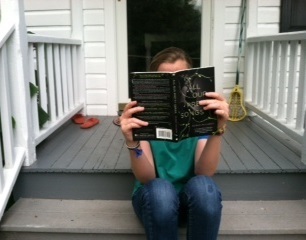
My 19 year old asked me for book recommendations this summer—she actually asked ME! And please do NOT tell her I’m writing this. Aware that I could scare her off by lending her my more literary faves, I quickly pulled down choices like Tina Fey’s “Bossyboots” and “Gone Girl.” I slipped in “The Light Between Oceans,” and that clever Sloan Crosleys “I Was Told There’d Be Cake.” Finally, I thought I’d dazzle her with Mindy Kaling’s “Is Everyone Hanging Out Without Me?” just to prove my cool factor is intact. I must have smiled all the way to bed that night.
So take hope ye mother’s of children connected to their cell phones and computers. Don’t despair you parents of instagrammers and Facebook friends. I share this as a tale of courage that somewhere, around the bend, you might just witness the payback, all those years after the initial investment.
www.leewoodruff.com facebook.com/leemwoodruff twitter@LeeMWoodruff
July 2, 2013
WHAT MY MOTHER IN LAW TAUGHT ME
These are some of the things I know to be true about my mother-in law:
She believed at all times that her four sons were perfect. And even if they weren’t, she never said otherwise in public.
The definition of a 1950’s era lady, her Revlon Moonrise Pink lipstick was applied at all times. Like most of us, she was never fully satisfied with her hairdo. 
Her signature saying, “It only takes a minute,” applied as equally to doing four loads of laundry or whipping up a steak dinner, as it did to driving from Detroit to New York to visit her grandchildren.
Homemade chocolate chip cookies were her calling card. They had verifiable magic powers to change the course of an illness, heal a broken heart, brighten up a new home, refresh a friendship, say “Merry Christmas” or just simply say “hi.” To know Frannie Woodruff was to have eaten one of her ultra thin and crispy chocolate chips, the secret of which she liberally shared -- extra butter and cake flour.
She was an early convert to Jackie-O size “transition” glasses, which meant the bug-eye lenses were usually a shade of dark purple, even when indoors. Although her sons mercilessly teased her, I realize now it was a device to see all, without ever letting four boys and a husband spot the whites of her eyes.
No matter what she ordered at a restaurant (usually Fettuccine Alfredo), when it came, 90% of the time, before she even tasted it, she remarked that she should have ordered what we did.
I’ve tried to imagine all the places she went in the pairs of white and black formal gloves that she gave to my daughters for dress-up, including one elegant opera length kid leather pair smelling faintly of smoke.
She knew bank tellers, grocery clerks, pharmacists, hairdresser, T.J. Max employees and just about everyone else by their first name.
Raising four boys in the 70’s who played every sport imaginable, she inexplicably cooked only one package of frozen corn at dinner, causing them to develop a lifelong habit of eating too fast.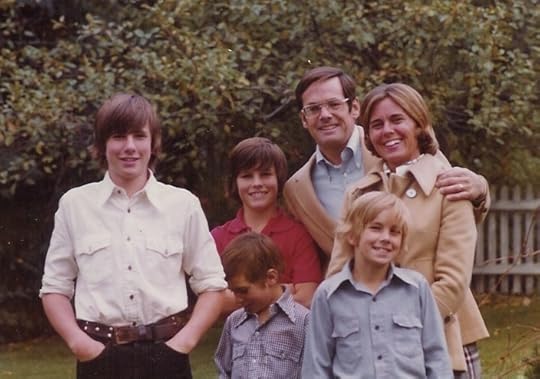
It was her personal philosophy to never say a bad word publically about other people.
She knew the names of every one of our neighbors in all of the cities we ever lived and kept up with some of them—adding them to her Christmas card list-- long after we’d moved.
She worshipped butter, whole milk, and cream sauces. Not long ago, her sister Lynnie bought a framed poster of a stick of butter and Frannie coveted it so much that she dragged Lynn to every Homegoods store in the greater Detroit metro area looking for its duplicate. In the end—they agreed to share it.
She could not have told you what NPR stood for and did not listen to it.
She taught me to set up the coffee maker in the evening so all you had to do was push a button in the morning.
She danced the Charleston like she had rubber bands for legs and she enthusiastically taught my children how.
She was an avid reader of mass-market fiction. We both shared a secret love of Sidney Sheldon.
We moved to nine places in 25 years of marriage (seven were domestic) and she was physically there for all seven. In each house she would unfailing set up the kitchen (my version of plunging toilets after an intestinal virus) and unpack boxes with me from dawn until long after the kids went to bed. I always gave up first.
She was such an enthusiastic and regular patron of TJ Max and Marshalls that on her 70th birthday, her local store had a nametag made for her.
She never spent a second worrying that she needed to fulfill herself or find her passion or broaden her horizons, and she could not have accurately defined the word “feminist.” She was 100% happy being a wife, mother and the “World’s Best Grandma,” although she never would have worn the T-shirt out of the house.
Never once in my presence was she able to work the TV controller, program the VCR or operate the cable box. She did, however, have a grasp on the volume button.
She set a gold standard, real life example of the word “devotion.” Watching her move through the world, I learned many important things that go into the secret sauce of being a wife, mother and good girlfriend --not just in the placid times, but when the going gets choppy.
She taught me you could drive a car with your left leg up on the console, a coffee cup balanced on the dashboard and the seat belt alarm circumvented by clever buckling.
She was the oldest sister of three girls (like me) and two brothers. Watching her interact with her siblings was my preview for how that bond of fun and interdependence would further strengthen, long after the kids are grown and flown.
Her cornflower blue eyes and signature dark “Dawson” brows and lashes were passed on to her lucky, lucky boys. (Why is it always the boys who get this gene?)
The famous story of Frannie -- one Pappagallo shoe on the flank of their black lab as she extruded a long stream of black plastic garbage bag out of the dog’s butt (he had escaped and eaten a neighbor’s garbage AND the bag) -- became an iconic metaphor in our house for some event, issue or what-have-you that just won’t end.
She was fortunate enough to die exactly the way she would have wanted -- in her own home, in her own bed, surrounded by her devoted husband and her beloved boys, and the repeated assurances (not that she needed them) that she was the most beloved, wonderful Mom in the world. And she was.
Rest in Peace Frances Dawson Woodruff – 1933 --- 2013
www.leewoodruff.com facebook.com/leemwoodruff twitter@LeeMWoodruff
June 20, 2013
Slowing Down Summer
It’s time to finish this next novel that’s dragged on like a bad cold for the past two years. The book tour in the fall and then on the road again in the first of the year- the joy of this paperback release were amazing opportunities to meet so many of you -- So thanks for your patience this summer in answering my website blog mail.
I will also be a little more subdued than usual on facebook, the twittersphere and all the other places I tend to express my opinions.
But never fear, I’ll be back with a vengeance in the fall, all charged up and ready to rumble. Have a terrific and prolific—but most of all relaxing summer.
lee
www.leewoodruff.com facebook.com/leemwoodruff twitter@LeeMWoodruff
May 22, 2013
The War Bike
There’s a butterfly scar on my left knee that I refer to as my war injury. It’s the legacy of a spectacular crash into a metal telephone pole support, while riding what my sisters and I fondly called “The War Bike.”
The War Bike had been my mother’s childhood transportation in the years following World War II. The wobbly, ox-blood frame had big, fat tires (not the chic beach bike tires of today) and an ungainly basket on the handlebars. Think of bobby-socked British school children riding along a country road in the 40’s. My legs were just a touch too short to sit down comfortably, so I spent a lot of time standing up and pumping the pedals. Riding it felt a little like piloting an ocean liner.
It’s amazing that the bike survived all those years in my grandparent’s garage to make it to our little center hall colonial in Delmar, New York. Objects today have a half-life of a nanosecond. We throw something out with a dent or a scrape. People were much thriftier back then; they repurposed things, recycled and re-used.
 Photo by Shane Henderson.
Photo by Shane Henderson.Riding the War Bike somehow connected me to a glorious past as I studied American history in school; one with freedom fighting revolutionary battles, brave Clara Bartons, the storming of Normandy beaches and concentration camp liberations. War heroes were our country’s legacy. They became leaders and achieved greatness back at home during peacetime. In the 1960s of my childhood, we viewed ourselves as a country on a giant uptick, the defender of liberty, the right side of the cold war, a legacy of the Greatest Generation, of Ike and Kennedy and champions of world-wide liberty. The War Bike stood for all of that, in some weird, inchoate way.
In the waning years of the War Bike’s utility and our childhood fixation with it, another war was rearing its head; and older brothers were sent from our neighborhood to Vietnam when their draft numbers came up. That war came into our living rooms on TV and in “Life” magazine images; the weary GIs in bandages, naked children running from the burning village. It was a very different conflict than the sweeping global wars that had preceded it and citizens protested, loudly questioning its purpose. That criticism began to rip at the seams of America.
When the young men and women came back from Vietnam, our nation marginalized their service. We muted their experience. It had been a divisive war, with no clear sense of victory. It simply wound down, with a heart-breaking black and white death toll.
With Vietnam, there had been no national pulling together, no Victory Gardens or gas rationing, no Pearl Harbor attack to rally around. And in its wake, we somehow skipped the welcome home. Serving your country, enlisting in the military, had gone out out of vogue. Veterans learned to pack their uniforms away, avert their eyes and shush up if questions arose. You talked about it only in the right company, or not at all. We let down a generation of young people who returned. We let down their families, their wives and mothers, their siblings and children, all of whom got a front row seat to bear witness to the ugliness of untreated internal wounds. The psychological damage. We didn’t know how to fix what we couldn’t see. It was more comfortable for our nation to ignore their damage, their scars and their service.
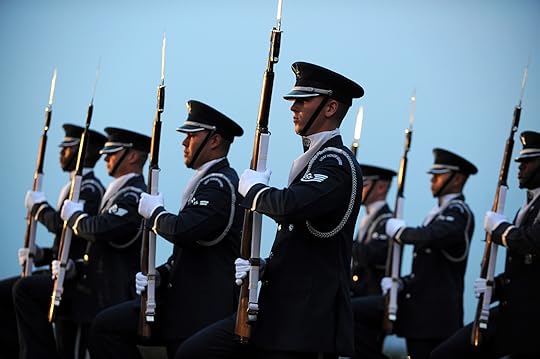 Photo by SrA Christina Brownlow.
Photo by SrA Christina Brownlow. I don’t recall what finally happened to the War Bike. It was eclipsed one birthday by a bright orange ten-speed with ram’s horn handlebars. After that my mother’s bike was forgotten; an unfitting, embarrassing relic for a pre-teen girl.
But dredging up those memories of my old self on the War Bike leads me to wonder how my own children view the concept of war. What is their perception of serving their country? How will they judge the present day conflicts with the benefit of hindsight and history? And how, in the long run, will they treat those who have come home requiring a lifetime of assistance?
With an all-volunteer military today, our children don’t have to ask themselves if they are willing to lay down their lives on foreign soil in service to their country. And when I personally ponder the question, I must admit it is a sobering sacrifice. As a mother, I’d have to think long and hard about that.
This Memorial Day, as we honor those who have given their lives, their limbs and their mental health and well-being when their nation asked them to go, let’s all take a moment to reflect on the real meaning of this holiday. Regardless of your politics, our veterans and their families deserve our nation’s respect and gratitude. We owe them the best chance to re-take the stage of their lives when they return home from the wars in Iraq and Afghanistan. Take a moment of silence on Monday to remember them, and to remind your children and neighbors just what that means. And then do something. Take action. It’s the best part of what it means to be an American. Give time, give dollars, learn more, discover what families have served in your town, investigate what organizations are helping vets at the grassroots level. Volunteer. Give back. It doesn’t take a huge investment to show a veteran that their sacrifices count.
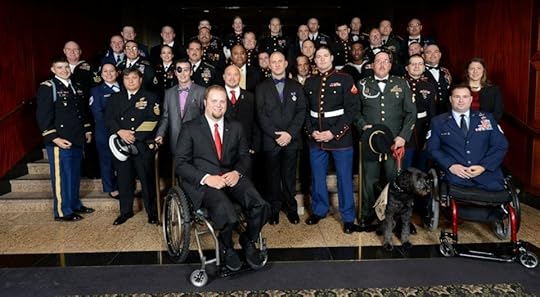 Photo taken by Stefan Radtke at Stand Up For Heroes, 2012, Remind.org.
Photo taken by Stefan Radtke at Stand Up For Heroes, 2012, Remind.org. One place to start is www.Remind.org.
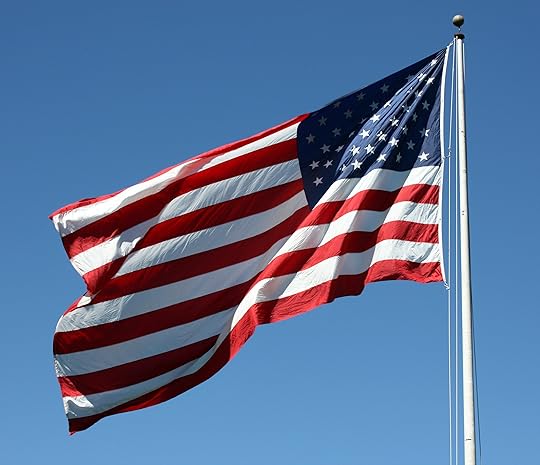
www.leewoodruff.com facebook.com/leemwoodruff twitter@LeeMWoodruff
May 8, 2013
IN PRAISE OF THE UNCOOL MOM
My mother was the exact opposite. Our after school snacks were carrot sticks and celery. Cranberry juice stood in for soda and there were no weekends spent trolling the mall for the latest shade of frosted pink lipstick. My mom’s idea of a good time, her reward for a day of chores and household maintenance, was to curl up every afternoon with a book.
My mother is a smarty-pants. An intellectual. Her idea of a challenge was reading Will and Ariel Durant’s classic “A Story of Civilization.” All eleven volumes. I kid you not. I proudly told friends in our upstate New York suburb that she had a master’s degree. Take that, all you girls who’s Moms got the Mary Tyler Moore flip curl and culottes! Her currency was never the latest hairstyle, although she did get a cropped “Beatles “ cut before I was born. She wasn’t the interior decorating type, a serious cook or gardener. She was bookish. And she reinforced the importance of that by example, taking us to the library from a very early age.
When we were old enough to ride our bikes alone, I loved the grown up feeling of consulting with the librarians, having my own library card (so COOL!) and then placing the books in my bike basket for transport home. I can’t quite articulate the feeling I still get walking into a library or a bookstore today. It’s a sense of endless possibilities and want. Entering a fashion boutique on Rodeo Drive or Fifth Avenue will never carry the same thrill. Books are a different form of acquisition, more lasting and fulfilling. My mother taught me that.

I picture my mother now, absorbed in her book; feet propped to rest her “throbbing veins,” (GROSS! we’d mouth to each other) as the late afternoon sunlight knifed through the living room window onto the mustard colored rug (yes, it was the 70’s.) The table was set for dinner; the roast was roasting, the vacuuming and dusting completed for the day.
Only now do I understand how reading buttressed her sense of individualism during the years when tending to our repetitive needs must have strip-mined her intellectual life. Books nurtured her own flame, especially as she navigated through three daughters’ teen years (oy vey), bubbling with hormones, churlishness and delayed gratification. It is in hindsight that I see how reading legitimized her presence among us. Books were her “cover” as she stationed herself in the living room chair, her antennae alert without meddling; such an under-rated attribute in today’s world of micro-managed parenting and helicopter hovering.
I don’t ever recall her telling me what to wear, criticizing a friend or offering up opinions about the boys who cycled in and out of our hearts (especially the one with the red Camaro who reeked of Marlboros.) Adolescence is a desert landscape of shifting sands and petty hurts. She was smart enough to recognize that the girl who excluded you from her birthday party one day is back as your bestie the next. My mother taught me how to be the bobber on the fishing line, not the hook with the bait.
You absorb things as a kid—even when you are trying not to. You tell yourself that when it’s your turn you will be a slightly different parent. You will edit, accept and reject. You will change things from the way you were raised, do it your own way. And sometimes you do. But I understand now what she was up to, each afternoon as we walked in the door from school. She was hanging back, holding her counsel and her tongue, being my parent, not my BFF. She was mothering—not smothering—and she gave me the space to learn for myself, to make my own decisions, choices and mistakes.
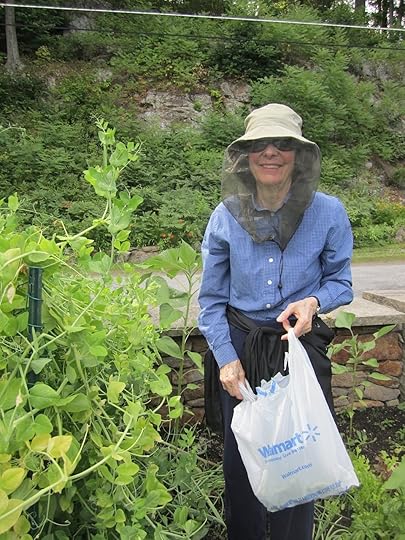
Now that I am a parent, working to instill a sense of well being and independence in frustrated by her occasional maternal indifference, I see that her approach required far more restraint than the dishy, tell-me-all tact. Those afternoons she spent at home, quietly reading, were a gift. They were an act of love equally as important as the love of reading.
www.leewoodruff.com facebook.com/leemwoodruff twitter@LeeMWoodruff

